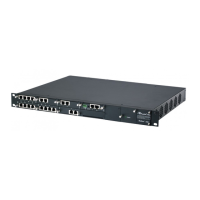Version 6.4 617 March 2012
SIP User's Manual A. Configuration Parameters Reference
Parameter Description
Note: When not configured (i.e., default), the SITQ850Cause
parameter is used.
Web/EMS: SIT Q850 Cause
For RO
[SITQ850CauseForRO]
Defines the Q.850 cause value specified in the SIP Reason header
that is included in a 4xx response when SIT-RO (Reorder - System
Busy Special Information Tone) is detected from the PSTN for IP-to-
Tel calls.
The valid range is 0 to 127. The default value is -1 (not configured).
Note: When not configured (i.e., default), the SITQ850Cause
parameter is used.
[GWInboundManipulationS
et]
Selects the Manipulation Set ID for manipulating all inbound INVITE
messages. The Manipulation Set is defined using the
MessageManipulations parameter. By default, no manipulation is
done (i.e. Manipulation Set ID is set to -1).
[GWOutboundManipulation
Set]
Selects the Manipulation Set ID for manipulating all outbound INVITE
messages. The Manipulation Set is defined using the
MessageManipulations parameter. By default, no manipulation is
done (i.e. Manipulation Set ID is set to -1).
Note: This parameter is used only if the Outbound Message
Manipulation Set parameter of the destination IP Group is not set.
Out-of-Service (Busy Out) Parameters
Web/EMS: Enable Busy Out
[EnableBusyOut]
Enables the Busy Out feature.
[0] Disable = 'Busy out' feature is not used (default).
[1] Enable = 'Busy out' feature is enabled.
When Busy Out is enabled and certain scenarios exist, the device
performs the following:
For analog interfaces: A reorder tone (configured by the parameter
FXSOOSBehavior) is played when the phone is off-hooked.
For digital interface: All E1/T1 trunks are automatically taken out of
service by taking down the D-Channel or by sending a Service Out
message for T1 PRI trunks supporting these messages (NI-2, 4/5-
ESS, DMS-100, and Meridian).
These behaviors are performed upon one of the following scenarios:
Physically disconnected from the network (i.e., Ethernet cable is
disconnected).
The Ethernet cable is connected, but the device can't
communicate with any host. Note that LAN Watch-Dog must be
activated (the parameter EnableLANWatchDog set to 1).
The device can't communicate with the proxy (according to the
Proxy Keep-
Alive mechanism) and no other alternative route exists
to send the call.
The IP Connectivity mechanism is enabled (using the parameter
AltRoutingTel2IPEnable) and there is no connectivity to any
destination IP address.
Notes:
For Analog interfaces: The FXSOOSBehavior parameter
determines the behavior of the FXS endpoints when a Busy Out or
Graceful Lock occurs.
For Analog interfaces: FXO endpoints during Busy Out and Lock
are inactive.
For Analog interfaces: See the LifeLineType parameter for

